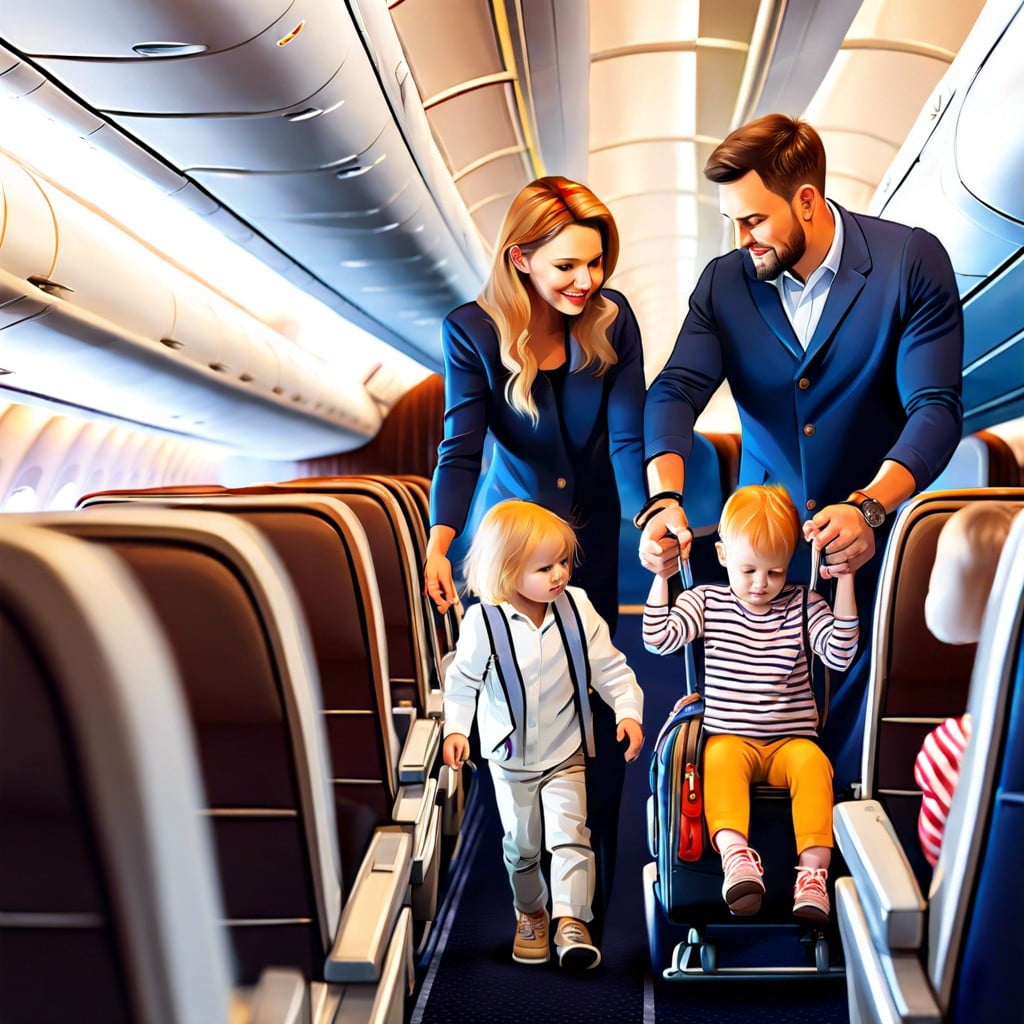Last updated on
Soaring high with little ones can turn into a memorable journey because this blog post uncovers creative strategies to keep kids entertained and comfortable on a plane.
Traveling with kids on a plane can often feel like navigating a labyrinth. But fear not, with the right approach, it can morph from a chaotic endeavor into an enjoyable journey. This article unravels practical tips and creative strategies, set to ease potential stressors from the packing process, in-flight entertainment, to tackling motion sickness.
Delve deeper to explore comprehensive solutions for family aviation adventures and transform those daunting travel plans into an array of cherished, sky-high memories.
Key takeaways:
- Dress children in removable layers for easy security checks.
- Pack essential items and comfort items in carry-on for easy access.
- Charge and load electronic devices with age-appropriate content.
- Discuss flight process with children beforehand to set expectations.
- Provide children with personal backpacks filled with snacks and entertainment.
Preparing for Takeoff: Essential Tips for Flying With Kids

Streamline the security process by dressing children in easily removable layers and slip-on shoes. Pack a quart-sized bag with travel-sized liquids to quickly present at checkpoints.
Familiarize yourself with airline policies regarding carry-ons and checked luggage. Optimize your packing to include a mix of essentials and comfort items within easy reach during the flight.
Charge electronic devices fully before departure and load them with age-appropriate, offline content. Ensure headphones are comfortable for little ears and volume-limiting for safety.
Discuss the flight process with children beforehand, from boarding to landing, to set expectations and reduce anxiety. Consider role-playing scenarios like using the seatbelt or asking for assistance.
Provide children with a personal, lightweight backpack containing snacks, a water bottle, and a favorite book or toy. This encourages responsibility and offers a sense of control over their travel experience.
Invest in child-friendly travel accessories such as neck pillows, earplugs, or eye masks to enhance comfort, especially during nap times or long flights.
Boarding and In-Flight Strategies

Efficient packing is crucial for quick access to essentials. Opt for a backpack as a carry-on, organizing items in zippered pouches: one for snacks, another for toys, and a third for hygiene products.
Board early when the airline calls for families with young children to give yourself ample time to get settled. If traveling with a partner, consider boarding separately; one adult can go ahead to set up the seating area with gear, while the other walks around the terminal to tire out the kids before boarding.
Inside the aircraft, contain the spread of items to avoid clutter. Keep a light blanket and a familiar toy handy to comfort your child and stick to routines as closely as possible.
In-flight, engage kids with a variety of activities, alternating between screen time, coloring, or quietly playing with small toys to maintain their interest. Maintain regular snack and meal times to prevent crankiness due to hunger. Encourage quiet play and use headphones for electronic devices to be considerate of fellow passengers.
For ear pressure during takeoff and landing, offer infants a bottle or pacifier, and older children can chew gum or yawn to alleviate discomfort.
Managing Challenges: Coping With Kid-Related Situations

Navigating turbulence isn’t only about the aircraft; it also refers to occasional bumps in the road of parenting. Equip yourself with a calm demeanor and an arsenal of solutions for when your child becomes restless or upset. A favorite toy, a surprise pack with new activities, or a pre-downloaded cartoon can work wonders.
When ears pop during take-off and landing, chewing gum or swallowing for older children and breastfeeding or a pacifier for infants offer relief. For the uncomfortable or fussy child, a walk down the aisle could be a welcome change of scenery. Seat-kicking sprees call for distraction tactics, like whispering a story or playing a quiet game.
Encounters with grumpy neighbors can be mitigated with empathy and a set of travel-size goodwill gestures such as earplugs or an apologetic smile. Practicing role-play games before the flight can also prepare children for the contained environment of a plane, teaching them about personal space and courtesy to fellow passengers.
The key lies in remaining flexible. If one approach fails, have a backup plan. Monitor your child’s behavior and nip any issues in the bud before they escalate. With empathy and creativity, you’ll foster a sense of adventure that turns challenges into part of the journey.
Navigating Mealtime: Satisfying Young Palates

Stave off hunger-induced fussiness by packing a variety of snacks. Think string cheese, fruit slices, and crackers – familiar, non-messy options that appeal to little taste buds.
For flights that coincide with meal times, pre-order a child-specific meal if the airline offers one; they’re often more suited to children’s preferences and served earlier, keeping hunger at bay.
To keep hydration levels up, bring an empty sippy cup or bottle to fill with water after security. Avoid sugary beverages that can lead to hyperactivity confined in a plane cabin.
Surprises can be a lifesaver. Tuck away a small, new snack that your child has never tried before. The novelty will provide distraction and entertainment when restlessness strikes.
Involve your children in the selection process pre-flight. Let them pick a few items to bring along. It promotes a sense of control and can reduce mealtime defiance.
Always have a backup. Delays happen, and on-board options might run out or not appeal to your child. A small container of their favorite cereal or freeze-dried fruit can save the day.
Lastly, remember that mealtime is a great opportunity to break up the monotony of the flight for your child, so try to make it an enjoyable interlude rather than a rushed necessity.
Safety First: Ensuring a Secure Journey
Always check that your car seats and boosters are FAA-approved for aircraft use, and familiarize yourself with the installation process on airplanes. Ensure they carry a label that certifies them for use on an aircraft.
For kids aged two and above, it’s advisable to buy them their own seat rather than keeping them on your lap for safety and comfort.
Carry a copy of your child’s medical information and an updated first-aid kit. Include essential items such as band-aids, antiseptic wipes, and age-appropriate pain relievers.
Discuss with your children the importance of following crew instructions and remaining seated when required. Also, practice putting on the oxygen mask or life vest if the airline provides a demonstration.
Pack any necessary medications in your carry-on, and ensure that they are easily accessible during the flight. Remember, you are allowed to bring medically necessary liquids in quantities larger than 3.4 ounces, provided you declare them at the security checkpoint.
Educate your children about the significance of keeping seatbelts fastened when seated, even if the sign is turned off, to protect them against unexpected turbulence.
Making Memories: Capturing and Preserving Travel Moments
Transform your family’s airborne adventures into a treasure trove of memories with these simple yet effective strategies:
- Photograph with Purpose: Rather than snapping away tirelessly, focus on capturing photos that tell a story. Aim for candid shots that depict the journey, not just the destination.
- Travel Journals: Encourage kids to keep a journal documenting their feelings, sights, and experiences. Stickers, ticket stubs, and drawings can add a personal touch.
- Collect Keepsakes: Inexpensively collect mementos such as postcards, currency, or natural items like shells, which can later be used to create a travel collage or memory box.
- Video Diaries: Use your smartphone to create short video diary entries. These clips offer a dynamic way to remember the trip, especially the amusing in-flight moments.
- Interactive Apps: Utilize travel-themed apps that allow family members to add remarks and photos, creating a live digital scrapbook of your travels together.
- Post-Travel Projects: Post trip, work on a family project like a photo album or a map with pinned destinations. This activity not only solidifies the experience but also extends the joy of the trip.
Community Connection: Engaging With Other Traveling Families
Bonding with fellow travelers can turn a routine flight into an enriching experience. Here’s how to connect with other families on the go:
1. Start a conversation at the gate or during boarding; shared travel excitement breaks the ice.
2. Bring small, shareable toys or games, a universal language that can engage children and parents alike.
3. Exchange travel hacks; seasoned family flyers are often treasure troves of invaluable tips.
4. Consider using social platforms or apps designed for connecting travelers, like family travel forums or airport meet-up groups.
5. Be open to sharing snacks; it can lead to shared stories and mutual support, especially during delays or long layovers.
6. Offer assistance to solo parents or families with young children; it’s a gesture that creates goodwill and fosters community spirit.
Benefits of Travelling With Kids
Traveling with your little ones opens up a world of valuable learning opportunities beyond the walls of a classroom. New cultures, languages, and environments stimulate their curiosity and understanding of the world. Plus, the shared experiences on the road can strengthen the family bond, creating a sense of unity and trust.
Spending time together away from the typical day-to-day distractions allows for deeper conversations and an appreciation for each other’s company. Additionally, diverse situations promote adaptability and improved communication skills among family members, as they navigate new experiences and challenges together.
Travel can also introduce children to novel recreational activities and forms of relaxation, from beach days to exploring national parks, ensuring that fun links with discovering new horizons. These authentic experiences not only enrich your family’s collective memory bank but also teach life lessons in an enjoyable and memorable context.
Educational Experiences
Travel broadens horizons and exposes children to new cultures, languages, and ways of life. Museums, historical sites, and nature reserves turn into immersive classrooms, offering kids real-world context to textbook knowledge.
They learn adaptability by navigating new situations and practice communication skills by interacting with diverse populations. Picking up a few words in a foreign language or understanding global geography firsthand instills a deeper appreciation for the world around them.
Meanwhile, participating in local customs and observing wildlife in their natural habitats fosters environmental awareness and cultural sensitivity at an early age.
Family Bonding
Sharing a journey strengthens connections as families navigate new environments together. The collective experience of tackling flight schedules, exploring destinations, or simply enjoying a meal at 30,000 feet fosters teamwork and mutual support.
- Problem-solving together, such as reading maps or deciding on activities, improves communication and trust.
- Limited distractions from daily life allow for more in-depth conversations and shared observations.
- Participating in adventures, like a snorkeling trip, creates shared memories and stories for years to come.
- Encountering new cultures as a unit enriches understanding and respect for diversity within the family.
Turn travel time into quality time by engaging in dialogue, playing games, or planning your trip’s next step. These moments of togetherness are as invaluable as the destination itself.
Improved Communication
Traveling as a family encourages dialogue between parents and children, fostering understanding on both sides. Conversations about different cultures, languages, and landmarks open new avenues for communication.
– Encourage kids to ask questions and express their curiosity about new surroundings.
– Discuss trip plans and expectations together, allowing children to feel involved and heard.
– Use travel delays and downtimes to share thoughts and feelings, strengthening family bonds.
– Promote language skills by learning a few words of the local language together.
– Create a travel journal where family members can write or draw their experiences and share with each other.
These practices not only reinforce the importance of clear communication but also equip children with enhanced social and verbal skills through diverse interactions during the journey.
Fun and Relaxation
Embracing new adventures leads to a treasure trove of giggles and shared stories. With each destination comes a playground of discovery, allowing children to unleash their boundless energy and imagination. Parents often find that their own stresses melt away as they join in on the fun, rekindling their sense of wonder through the eyes of their little ones.
Consider these points to maximize enjoyment while traveling:
- Incorporate play: Whether it’s a game of I-Spy at the airport or a mini scavenger hunt around your destination, playful interactions keep spirits high.
- Balance activities: Mix stimulating excursions like theme parks with low-key options such as beach days to prevent burnout.
- Build in downtime: Schedule moments of rest to rejuvenate, whether it’s a quiet afternoon in a park or a movie night in your hotel.
- Capture joy: Take photos, but also encourage kids to draw or write about their favorite moments, creating a personalized travel capsule.
Tips for Travelling With Kids
Planning ahead is essential to a smooth travel experience with children. Research and book kid-friendly accommodations and activities beforehand to ensure they’re suitable and engaging for your family.
Establishing a routine can be a lifesaver, even on vacation. Maintain regular meal and sleep times to help kids feel secure and reduce meltdowns.
Involving your kids in planning can enhance their excitement. Let them choose an activity or pack their own carry-on with favorite snacks and toys.
Remember the power of breaks. Schedule downtime to rest and recoup, preventing overstimulation and crankiness.
Finally, keep in mind that flexibility is key. Sometimes, despite the best plans, a quick adaptational shift is what keeps the travel spirit alive.
Plan Ahead
Crafting a detailed itinerary can ease much of the stress associated with air travel. Start by selecting flights that align with your child’s sleep patterns, reducing the likelihood of mid-air meltdowns.
Reserve seats early to ensure your family can sit together, preferably near the front of the plane for a quicker disembarkation. Pack wisely by including a carry-on with snacks, activities, and a change of clothes for your little ones.
Lasty, familiarize yourself with airport layouts and the boarding process. These proactive measures will lay the groundwork for a smoother journey.
Creating a Routine
Having a set routine can be a game-changer for traveling with little ones. It instills a sense of familiarity and security even when they’re miles up in the air. Here are some strategies to keep your child’s rhythm consistent:
- Sync flight times with nap or bedtimes when possible. This can encourage them to sleep during the journey.
- Pack familiar items like a favorite blanket or toy to maintain a sense of home.
- Break the trip into a series of steps (check-in, boarding, etc.) and explain the process to children beforehand, so they know what to expect.
- Maintain meal and snack times to keep hunger-related meltdowns at bay.
- Designate time for quiet activities like coloring or reading, alternating with more active engagement like in-seat exercises or walking down the aisle if permitted.
- Stick to bedtime rituals: if you read a story every night, bring a book and do the same before trying to get them to sleep on the flight.
Implementing these points will not only help maintain a peaceful flight, but it’ll also ensure your child feels secure, making the travel experience more enjoyable for everyone.
Involve the Kids for Entertainment
Including children in planning and packing their carry-on entertainment not only gives them a sense of control but also ensures they are occupied with activities they enjoy. Encourage them to select a mix of items, such as their favorite books, drawing pads, travel-sized games, and a tablet pre-loaded with age-appropriate apps and movies.
Let them choose a small selection of toys to bring along, ideally ones that are quiet and mess-free. Create a travel playlist together with songs they love, which can be a great way to calm nerves and pass the time. This participatory approach makes kids more invested in their in-flight happiness and teaches them valuable organizational skills.
Take Breaks
Intermittent pauses in your travel itinerary can be pivotal for keeping kids upbeat and harmonious. Taking breaks allows for:
- Energy release: Find play areas in airports or make quick stops during road trips for physical activity.
- Snack time: Refuel with healthy snacks to maintain energy levels and mood.
- Rest: Short naps or quiet time with a book or tablet can prevent overstimulation.
- Bathroom visits: Regular intervals help avoid accidents and discomfort, especially for toddlers in potty training.
- Exploration: Let curiosity flourish by exploring different airport shops or scenic spots en route.
Remember, a flexible schedule often leads to more smiles and fewer meltdowns.
Recommended Family-Friendly Destinations
Walt Disney World, Florida, offers a magical escape where children can meet their favorite characters and families can enjoy rides and entertainment suitable for all ages.
San Diego, California, is a treasure trove of outdoor adventures and educational experiences with its famous zoo, beautiful beaches, and interactive museums.
Costa Rica invites adventurous families to explore nature with its stunning beaches, lush rainforests, and wildlife encounters that educate and entertain.
These destinations provide a mix of activities to cater to diverse interests, ensuring that every family member finds something to love. Whether seeking theme park thrills, educational outings, or natural exploration, these spots stand out for their broad appeal, top-notch facilities, and commitment to creating memorable family experiences.
Walt Disney World, Florida
Walt Disney World in Florida is a dream destination for families with children of all ages. Here’s what makes it exceptional:
- Wide Range of Attractions: From thrilling roller coasters in Magic Kingdom to the educational experiences in EPCOT, there’s something for everyone.
- Character Experiences: Meet-and-greets with beloved Disney characters create unforgettable moments for kids and parents alike.
- Entertainment Options: Parades, fireworks, and live shows happen daily, captivating guests with spectacular performances.
- Advance Planning: Use the My Disney Experience app to book FastPass+ selections, making wait times shorter for popular rides.
- Dining Varieties: Multiple cuisine options cater to picky eaters and foodies. Character dining experiences are a hit for memorable meals.
- Accommodation Choices: On-site resorts offer themes that delight kids, with easy park access and extended park hours for guests.
- Seasonal Events: Visit during special times like Halloween or Christmas for unique holiday-themed festivities that enchant the entire family.
Remember, comfort and enjoyment are vital, so consider downtime at your resort pool for restful breaks from the exhilarating park activities.
San Diego, California
Famed for its year-round pleasant climate, San Diego is a treasure trove of child-friendly attractions. The San Diego Zoo, a global leader in animal care and conservation, is home to over 3,500 rare and endangered animals, sure to captivate the curiosity of young minds.
Next, venture to Balboa Park, where museums, playgrounds, and the Marie Hitchcock Puppet Theater offer a diverse cultural experience.
The beaches of San Diego, such as La Jolla Cove, provide a perfect backdrop for sandcastle building and tide pooling—natural touch tanks for little explorers.
For interactive fun, the New Children’s Museum encourages kids to think, play, and create with hands-on exhibits and art-making activities.
And a visit to LEGOLAND California, just a short drive from the city, offers thrill rides and the chance to immerse in a world built from millions of LEGO bricks.
San Diego showcases the beauty of outdoor activities that engage children while giving them room to burn off energy, ensuring they are happily tired by the end of the day.
Continue reading:
Recap




